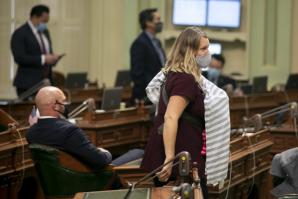Prior to Jan. 1, the California Family Rights Act required employers of 50 or more employees to provide eligible California employees up to 12 workweeks of unpaid, job-protected leave during any 12-month period to bond with a new child or care for themselves, a child, parent or spouse. In 2018, the California New Parent Leave Act effectively expanded the CFRA, providing child-bonding leave to employees of employers with 20-49 employees.
Perhaps the most significant employment legislation of 2020, Senate Bill 1383 repealed the CFRA and eliminated the NPLA, replacing those laws with a new CFRA that includes smaller employers, adds qualifying reasons for leave and adds family members for whom leave may be used. It also eliminates certain reinstatement exceptions, a notable break from the CFRA’s federal counterpart, the Family and Medical Leave Act.
Here’s what employers need to know about the new law that took effect Jan. 1.
The New Guidelines
The new CFRA expands coverage to California employers with five or more employees. Smaller businesses that never provided CFRA leave must comply with the new law, including its complicated notice and documentation requirements. To qualify for CFRA leave, employees must have worked for the employer for 12 months and 1,250 hours within the last 12 months.
The new CFRA also expands the qualifying reasons for leave. In addition to eligible employees being able to take leave to bond with a new child or care for themselves, a child, parent or spouse, they may also take leave to care for a sibling, grandparent, grandchild or domestic partner with a serious health condition.
The definition of child also has been modified to remove the requirement that one must be under 18 or an adult dependent child and includes the child of an employee’s domestic partner. Now an employee may also take leave to care for a domestic partner’s child or a child with a serious medical condition, regardless of the child’s age.
To align more closely to the FMLA, the new CFRA also adds military exigency as a qualifying reason for leave. Employers must provide leave related to the covered active duty of an employee’s spouse, domestic partner, child or parent in the armed forces.
Other changes also affect larger employers already subject to the CFRA. For instance, previously, parents who worked for the same employer could only take a combined total of 12 weeks of leave to bond with a new child. Now, each parent may take 12 weeks. Additionally, key employees (defined as the highest paid 10 percent) may no longer be denied reinstatement. All employees have the same reinstatement rights, regardless of their pay and responsibilities.
Case Study No. 1
In most instances, the FMLA and the CFRA will run concurrently when taken for the same qualifying reason. However, because the new CFRA provides more reasons for leave than federal law, larger employers can expect to see certain instances where an employee separately has access to 12 weeks of the CFRA and 12 weeks of FMLA leave, which could result in 24 weeks of job-protected leave in any given year.
John’s grandmother is diagnosed with a serious health condition and is unable to care for herself. For two years, John has worked full-time for a company with 60 employees. He requests 12 weeks of leave to care for his grandmother. Within the same year, John’s child is also diagnosed with a serious health issue. John requests an additional 12 weeks of leave to care for his child.
Because grandparents are now covered under the CFRA (but not the FMLA), John would be eligible to take 12 weeks of CFRA leave to care for his grandmother. He would still be eligible to take 12 weeks of FMLA leave to care for his child. Under this unique dilemma, John’s employer could be faced with providing him 24 weeks, or about 5 1/2 months, of protected leave.
Case Study No. 2
In addition, all CRFA-covered employers may have to provide up to seven months of job-protected leave to eligible pregnant employees.
Jamila’s employer has 14 employees. Jamila, who is pregnant, becomes disabled due to the pregnancy around her sixth month and cannot work. She would be entitled to up to four months of leave under California’s pregnancy disability leave law. After she has her baby, she would be entitled to another 12 weeks of CFRA baby-bonding leave, for a potential total of about 30 weeks, or seven months, of protected leave. And Jamila’s husband, who has worked for the same company for two years, would also be eligible for 12 weeks of CFRA baby-bonding leave, which he may take at the same time as his wife.
Next Steps
All businesses covered by the CFRA should review and revise policies and procedures, including employee handbooks, to ensure compliance with its expanded leave rights.
Small businesses not previously covered under the CFRA are encouraged to plan for providing up to 12 weeks of job-protected leave to qualifying employees and to draft and implement family and medical requests and other related forms.
Larger employers covered prior to 2021 should review their forms and processes to address the changes effective this year.
Finally, employers must post a new CFRA poster, available on the California Department of Fair Employment and Housing website (www.dfeh.ca.gov). Employers should consult with experienced employment law counsel when navigating these complicated leave issues.
Laura C. McHugh is a shareholder with Duggan McHugh Law Corporation, which focuses on advising and representing employers. Consuelo I. Amezcua is an associate attorney at Duggan McHugh Law Corporation.
–
Stay up to date on the effects of the coronavirus on people and business in the Capital Region: Subscribe to the Comstock’s newsletter today.
Recommended For You

Three COVID-19-Related Laws to Know
Several 2021 laws focus on issues related to COVID-19.

Nail-Biter for Family Leave Bill Reveals Tough Realities for Working Moms
Why did a lawmaker need to bring her newborn to the COVID-exposed state Capitol to do her job? To help pass a new family leave law.

Who Cares
Women continue to balance the responsibilities of career with caregiving as the population ages
The AARP has a family caregivers discussion Facebook group with just 2,100 members, though a highly active feed. Most of the posts are written by women, though men find advice and solace there also.

Child Care Crisis
The region’s shortage is at critical levels, and part of the problem is not enough space. Capital Region leaders are looking for ways to get more facilities up and running.
As of 2017, Sacramento County had enough licensed child care slots to accommodate little more than a quarter of children with working parents. State and local officials are spearheading efforts to change that.




